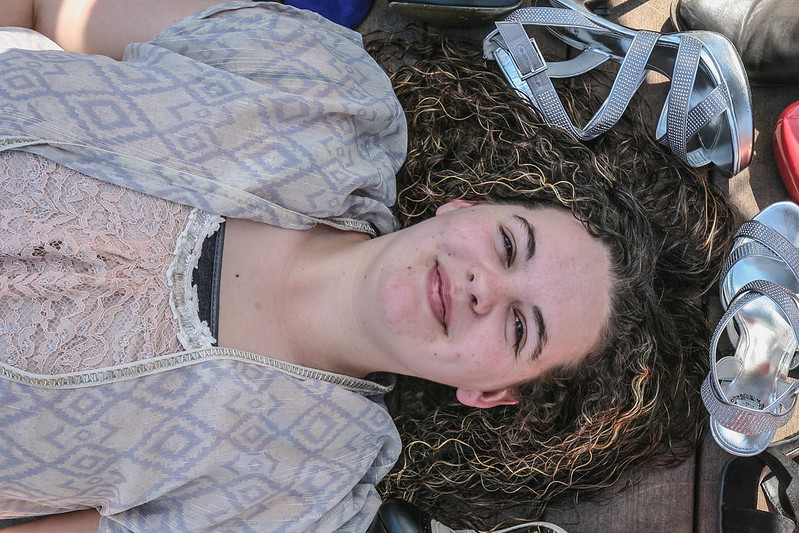-
Tutti Frutti Ice Cream at Eddie’s Sweet Shop
A couple of years ago, I was contacted by the owner of Eddie’s Sweet Shop in Queens, New York. He had seen my article on searching for tutti frutti ice cream, and wanted to let me know that his shop in Queens has been selling tutti frutti ice cream for decades.
Last month, I was staying in Manhattan, and made the trip over to Queens to visit Eddie’s. Lo and behold, right there on the menu, and even spelled correctly, was tutti frutti ice cream.
I ordered a cone of it, and tried to both relish the long-awaited experience, and analyze what exactly I was tasting. It seemed like a plain ice cream base; I did not detect any vanilla, so I presume just plain ice cream.
It went too fast, and I wasn’t done relishing and analyzing. So, to the surprise of the clerk behind the counter, I ordered second cone. He asked me how long it had been since I last had tutti frutti ice cream. “This is it, right here. I’ve never had it before today. I’ve been looking for it for nearly thirty years.”
There were bits of fruit; I would guess glacé fruit. The flavor of the fruit melded lightly with the flavor of the plain ice cream. The ice cream was pink in color; I do not believe that much pink color came from the fruit, so I suppose that some food coloring was added.
And that’s about it. Tutti frutti, Italian for “all fruit”, seems to literally be ice cream with bits of fruit in it. I feel confident that I could make something at home with a consumer ice cream machine that would be similar.
(If you wanted to buy ice cream off the shelf that tastes like what I had at Eddie’s, I think the closest commonly-found option might be Breyers Cherry Vanilla. Obviously not an exact match.)
I know of at least two other shops in the United States which make tutti frutti ice cream. I hope to someday try their offerings as well, but given the history of Eddie’s Sweet Shop, I feel confident that this was authentic tutti frutti. If the other shops have something different called tutti frutti, then that may well be authentic also.
In the 1990s I learned how to make web pages, and my first web page was to write up what I had learned searching for tutti frutti ice cream. My personal web page has taken on various forms since then, but I have always kept that content around, and added to it from time to time. I have corresponded with people across the planet, many either searching themselves, and some offering help on what they remembered tutti frutti ice cream to be like.
I really don’t even like ice cream that much, and if I ate anything of the sort, which is infrequent, I’d prefer something like a turtle sundae with frozen custard, or maybe frozen yogurt with bits of chocolate candy. But thanks to Eddie’s Sweet Shop, my search for tutti frutti ice cream has come to a successful close. It is good ice cream. Should I visit Queens again, I would certainly want to go back for another cone. And maybe try another flavor too.
-
Canon EF 16-35/4 IS
For about a decade, Canon offer SLR camera users two high-quality ultra-wide zoom lenses: the 17-40/4 and the 16-35/2.8. The 16-35/2.8 is a full stop wider in aperture, and also about twice the price. I used the 17-40 for years, which worked great outdoors in adequate light, but, with the f4 aperture, was limited for indoor use, such as for museum exhibits and indoor architecture. The wider f2.8 aperture would help, but what I thought would really be great was image stabilization on the f4 lens.
I must not have been alone in thinking such a lens would be useful, as in 2014 they introduced 16-35/4 ultra-wide zoom lens with image stabilization, for just a couple hundred dollars more than the 17-40/4.
At 16mm
At 35mm
Image Stabilization
The image stabilization works well for moderately dim interiors, like typical museum exhibits:
When the interior lighting is extremely dim, the lens’s image stabilization might not be enough to attain a blur-free handheld photo, but it’s still better than nothing:
 </p>
</p>Of course, image stabilization only helps motion blur introduced on the photographer’s side. If your subject is moving, having the f2.8 aperture would be more helpful. But for reasonably static scenes, Canon purports that the image stabilization unit compensates for up to four stops worth of aperture, far exceeding what the f2.8 lens offers without image stabilization.
Portraits
One typically does not reach for an ultra-wide lens for portraits, but sometimes the focal length works out, both at the 35mm end:
and at the 16mm end:
I do think that the extra 5mm on the 17-40 lens is more useful than the extra 1mm on the 16-35 lens, but the image stabilization more than makes up for than in overall value.
-
Floorplans from Green Tea Software
 I have had an Apple iPad for over five years now. Before the iPad existed, I envisioned a sleek portable tablet as a great productivity tool, and have been somewhat disappointed that — either through system design or through decisions of third-part application developers — the iPad seems better suited for consuming digital content than for creating it.
I have had an Apple iPad for over five years now. Before the iPad existed, I envisioned a sleek portable tablet as a great productivity tool, and have been somewhat disappointed that — either through system design or through decisions of third-part application developers — the iPad seems better suited for consuming digital content than for creating it.In working out plans for a new house construction, I found the Floorplans application from Green Tea Software. This is by far the most intuitive, easy-to-use floor plan tool I have yet tried on the iPad. More significantly, it makes using the iPad for content creation a breeze. It’s easy to sneak in a few minutes of floor plan design after breakfast, while watching television, or while fully engaged in the application for hours at a time.
I have long thought that it would be great if there were an iOS content creation application that was as easy to use as playing Yahtzee on my phone. Green Tea Software has delivered! Unfortunately, I don’t expect to be a long-term user of their software, as I don’t plan a new house very often, but their work inspires me that it is possible for great productivity software for the iPad can exist.
-
Grain-free Dog Food and Local Shopping
 Visiting the western Chicago suburb of Naperville, I was surprised to see so many people walking around the downtown outdoor shopping area on a chilly, dreary Sunday afternoon. Has not online shopping disrupted in-person shopping nearly to the point of oblivion? Happily not!
Visiting the western Chicago suburb of Naperville, I was surprised to see so many people walking around the downtown outdoor shopping area on a chilly, dreary Sunday afternoon. Has not online shopping disrupted in-person shopping nearly to the point of oblivion? Happily not!We stumbled upon a small pet store with a cordial and well-educated staff. Very unlike when shopping at a certain major chain pet store — which I almost dread going into after repeated inexplicably mediocre customer service — here we learned more details about the reasoning behind grain-free dog food.
“Dogs can’t digest grain very well,” the employee said. “But the grain still as an effect on them. Eating too much grain can result in increased shedding, dry skin, diarrhea, and discharges through their eyes.”
All of the food they sold at the store was grain-free. What about the treats?
“Most of our treats are grain-free also, but a small amount of grain in treat is okay, since treats aren’t the main source of food.”
What about Samantha the border collie’s favorite treat, of fresh made whole wheat biscuits baked with butter? No comment, apparently… But now that we’ve learned, through helpful staff at a locally-owned brick-and-mortar store, the downside to grain in a dog’s diet, Samantha will be eating increasingly grain-free.
[The store does offer online shopping as well.]
-
Weeding the Worst Library Books
 The New Yorker has an article this week on Weeding the Worst Library Books. Have you ever been perusing the shelves of your local municipal public library and wondered why they keep such old, weird, pointless, and/or useless books sitting around? “Weeding” is the delicate art practiced by librarians whereby books are selected to be discarded in order to make room for new books to arrive. Apparently this is best done only a few books at a time, rather than forty thousand books all at once, as attempted by former Berkeley library director Jeff Scott.
The New Yorker has an article this week on Weeding the Worst Library Books. Have you ever been perusing the shelves of your local municipal public library and wondered why they keep such old, weird, pointless, and/or useless books sitting around? “Weeding” is the delicate art practiced by librarians whereby books are selected to be discarded in order to make room for new books to arrive. Apparently this is best done only a few books at a time, rather than forty thousand books all at once, as attempted by former Berkeley library director Jeff Scott.The library’s director, Jeff Scott, announced that his staff had “deaccessioned” texts that weren’t regularly checked out. But the protesters who gathered on the library’s front steps to decry what became known as “Librarygate” preferred a different term: “purged.” “Put a tourniquet on the hemorrhage,” one of the protesters’ signs declared. “Don’t pulp our fiction,” another read. … A thousand people signed a petition demanding that Scott step down—and, in the end, he did.
What kinds of books get weeded out, exactly, and why? The article introduces us to librarians Mary Kelly and Holly Hibner, who maintain a weblog about library books likely to be on their way out the door. Some books are highly desirable to be on the shelves, but get worn out from years of use. These may well be discarded only to be replaced with a fresh copy.
Many more books are shown the door by virtue of their antiquated content: books about applying for jobs in the 1970s, or projecting what things might be like if we could ever launch a spacecraft off the planet. Other books perplex and mystify today’s readers who wonder why the book ever existed in the first place, such as an illustrated children’s guide to Wax In Our World.
I feel that I understand, though, the bitter reaction toward book weeding. I only have so much space on my own home library shelves, and sometimes I feel wistfully compelled to clear out some older books to make room for newer. Even when the practical utility of the old books is obviously minimal (e.g., discarding a first edition of The Java Language Specification while keeping the third edition), a mixture of emotional attachment and vague concern that a legitimate use case might arise makes weeding challenging.
Browsing Mary and Holly’s blog about discarded library books is encouraging, though! If you fancy the idea of writing a book, but aren’t sure that you have any ideas that would be worth putting into book form, there are almost certainly numerous examples of worse book ideas already out there…








